Grand Prix – Richmond. Second-largest Magic tournament of all time. More players, measured in thousands, than sleep, measured in hours. Plenty of things to be learned and stories to be told from the logistics of this gargantuan event, but for now, two areas I’d like to focus on, inspired by two judges who came in with the goal of avoiding being mentioned by name here. Talk about temping the fates.
First up – Shawn “Super Grande” Doherty (who reminds us that when in doubt, always buy the Super Grande. Long story from Valencias past), who sadly does not avoid this remedial lesson on result slips for both players and judges alike.
Let’s play a little game. I’ll show the result slip (with names and other identifying marks blurred to protect the innocent and guilty alike – the blurring itself is not a trick and never part of the solution) and you tell me what the problem is. A little later on, we’ll go over your answers. These are all real result slips submitted over the course of the Grand Prix, and if any of these or anything like this is you, then you’re inadvertently (I hope) contributing to making things harder and take longer. Ready to play?
1.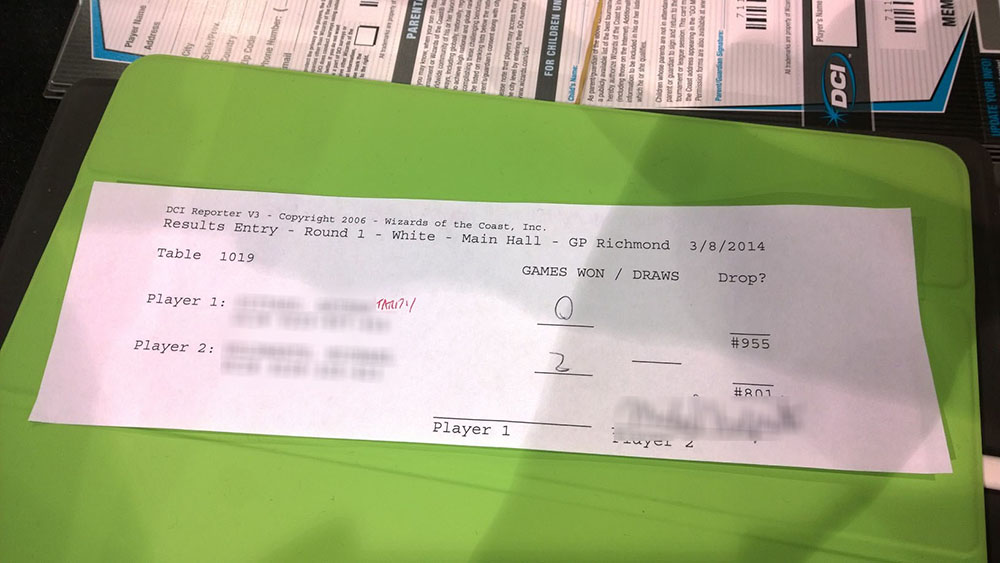
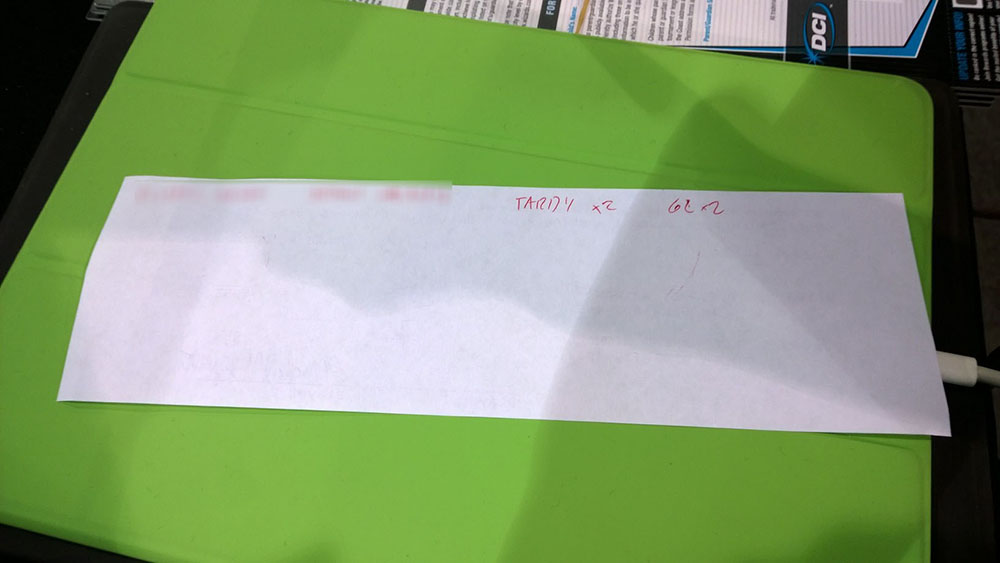
2.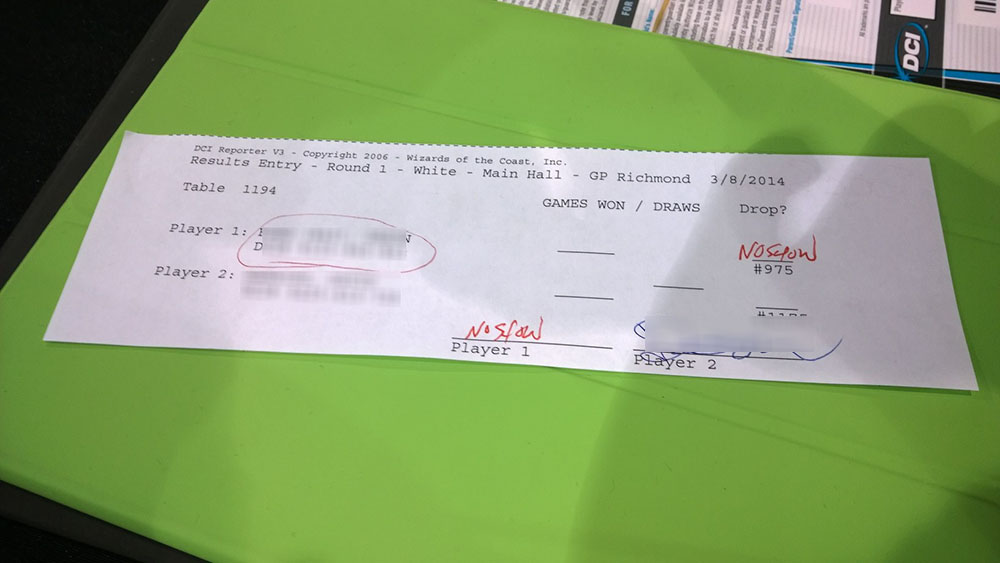
3. 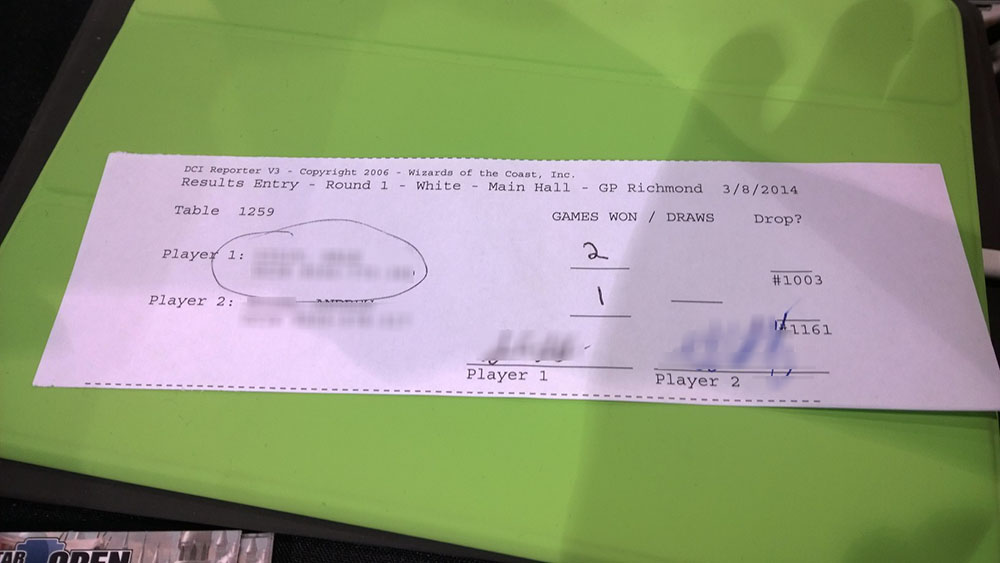
4.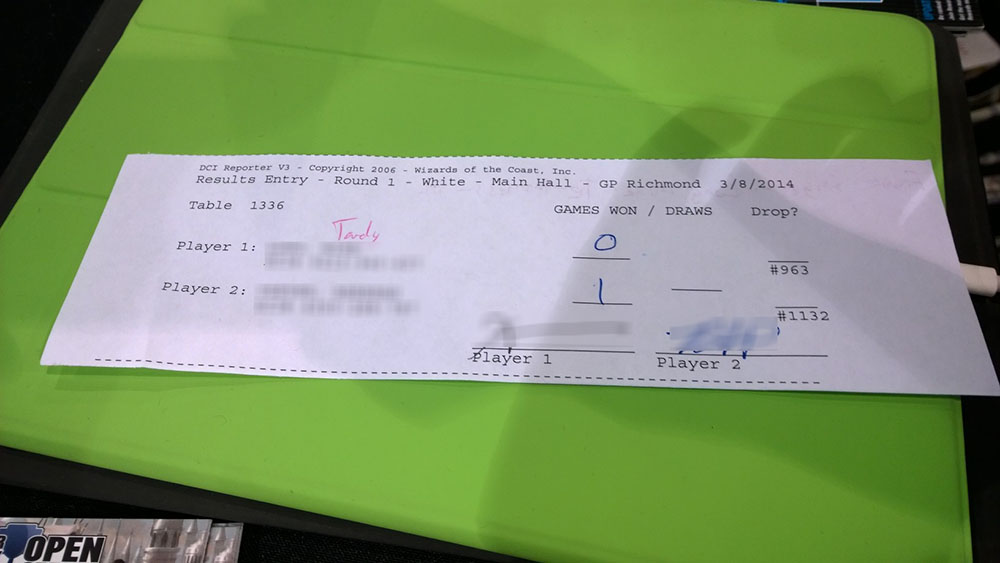
5.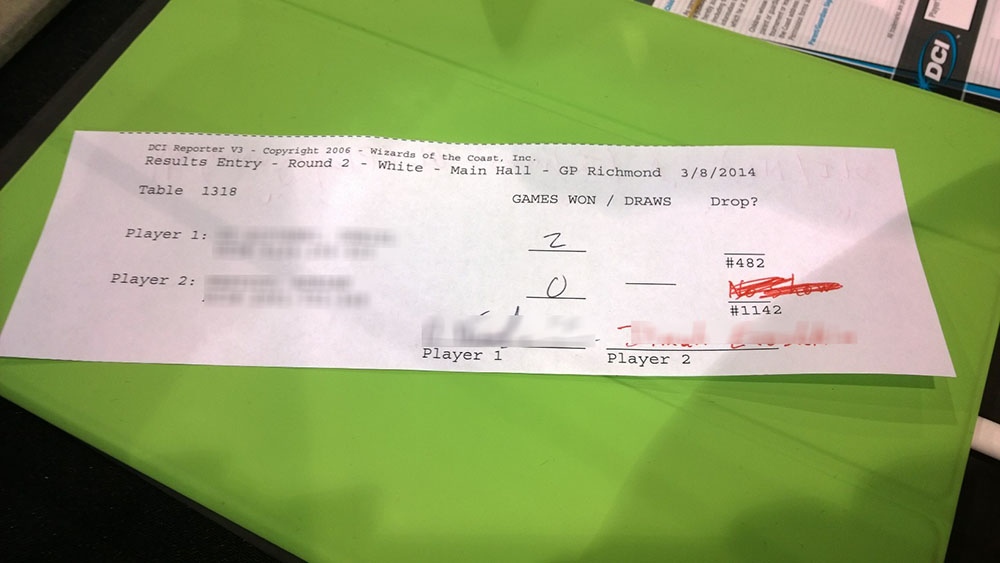
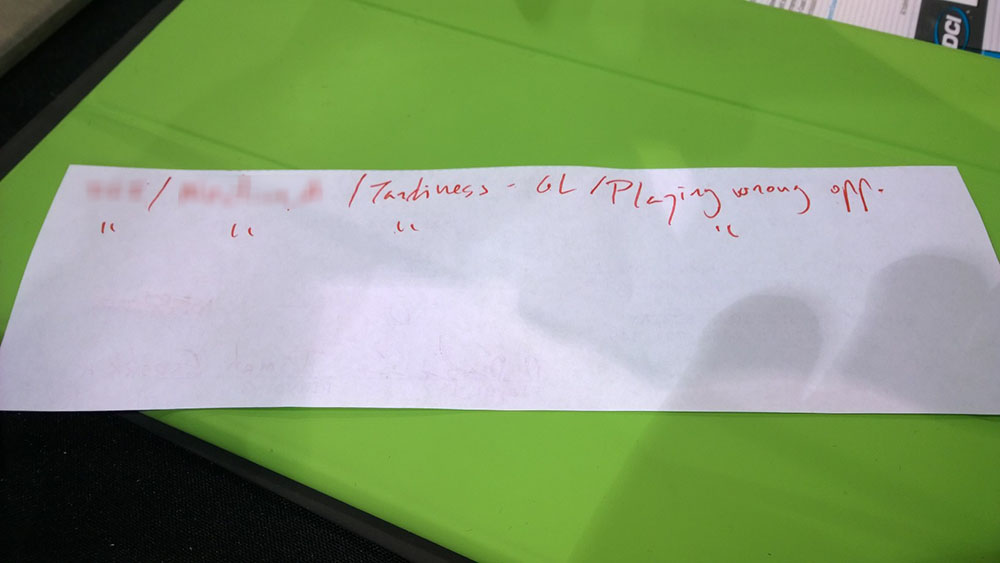
6.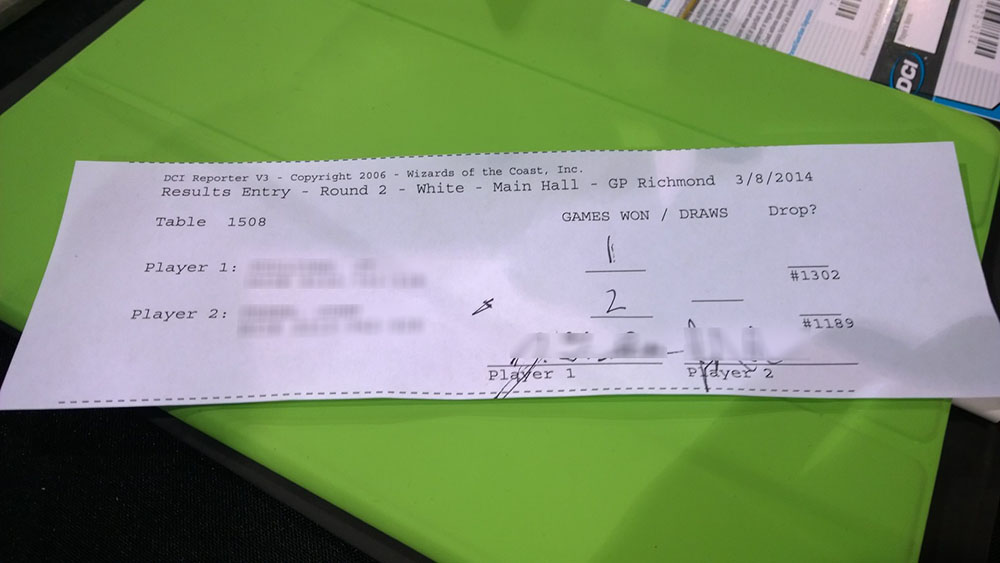
7.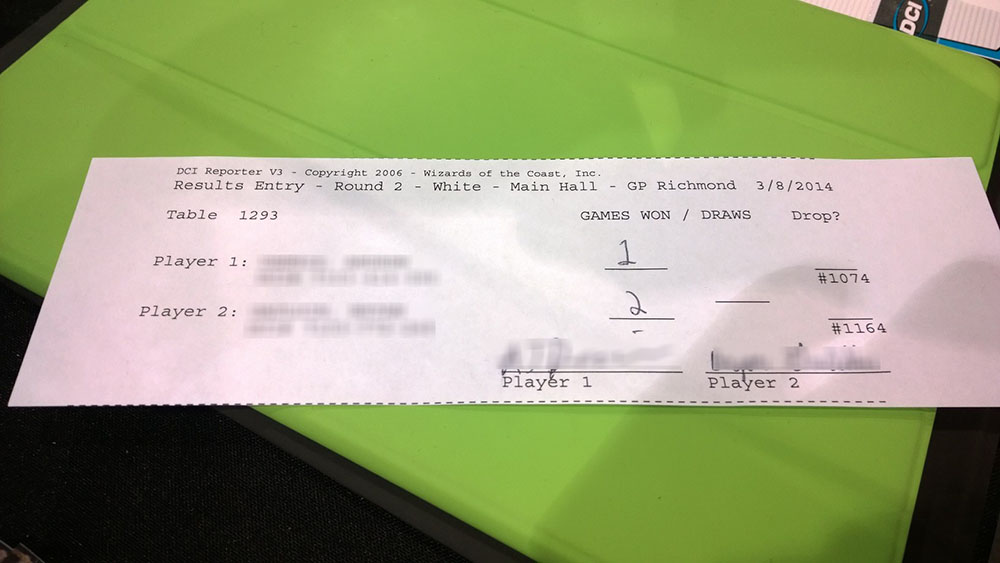
8.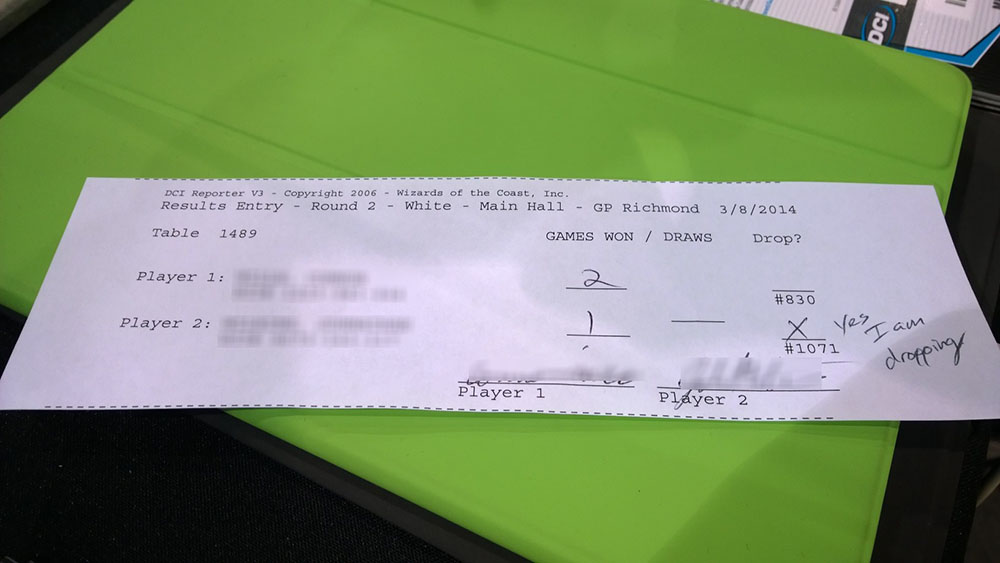
9.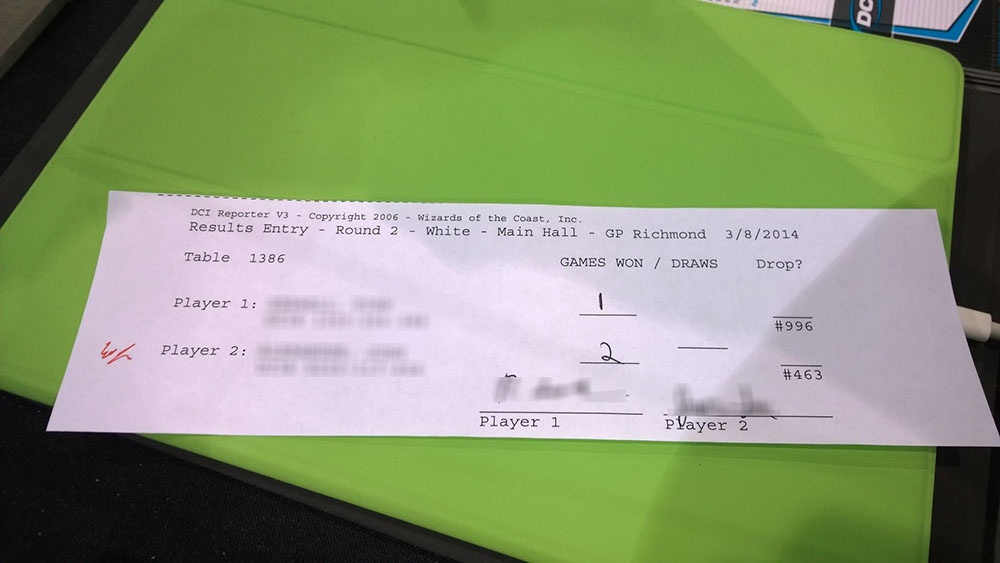
10.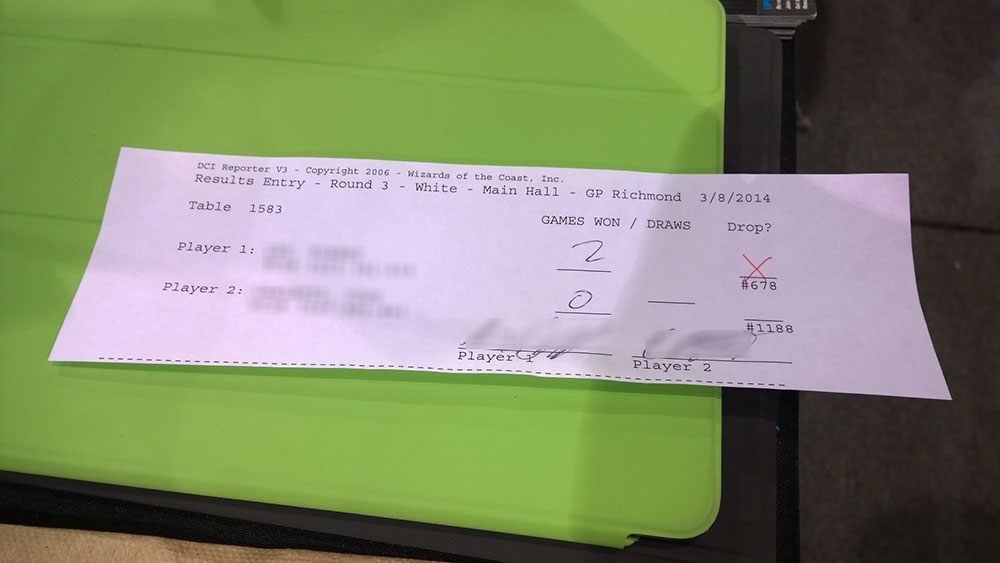
11.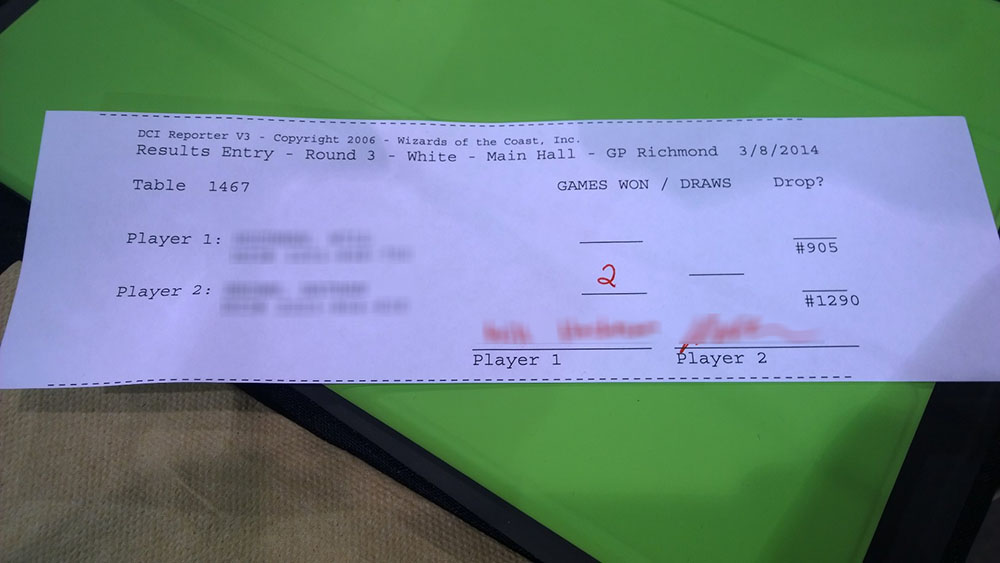
12.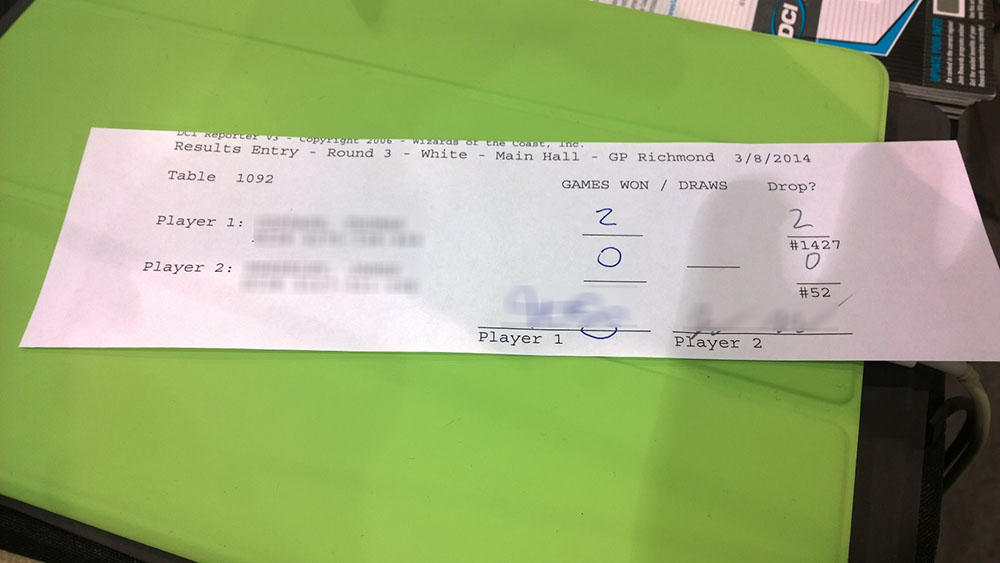
13.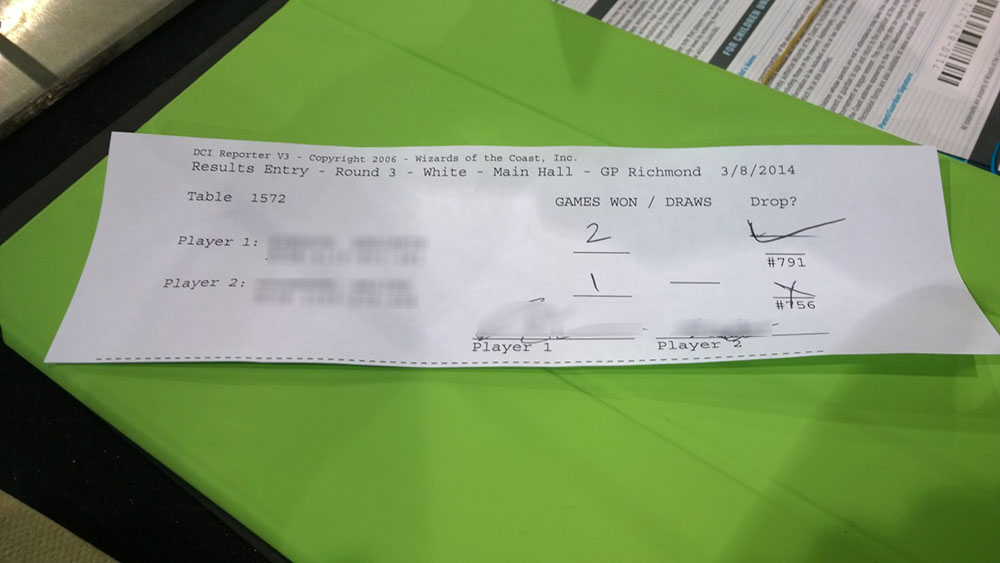
14.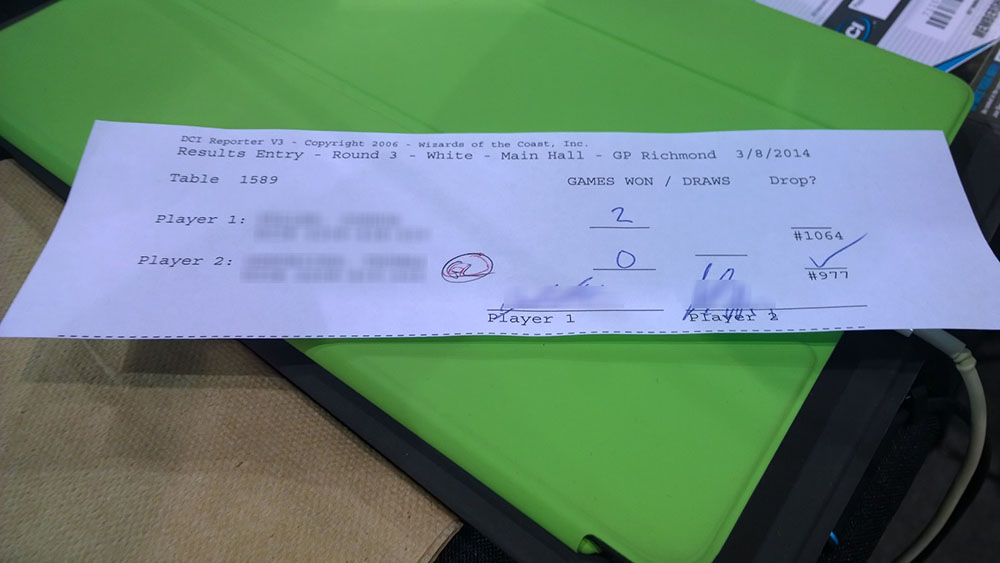
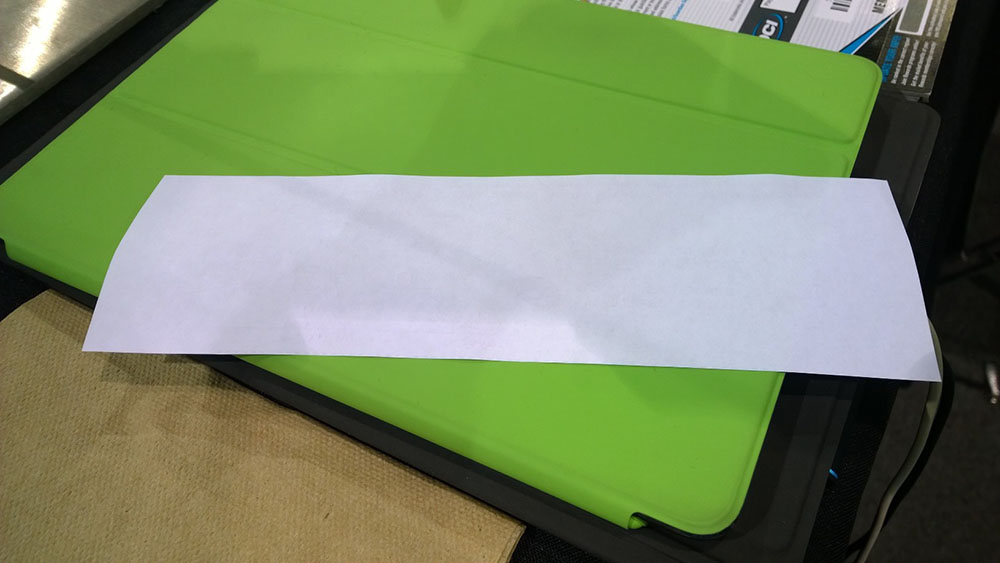
15.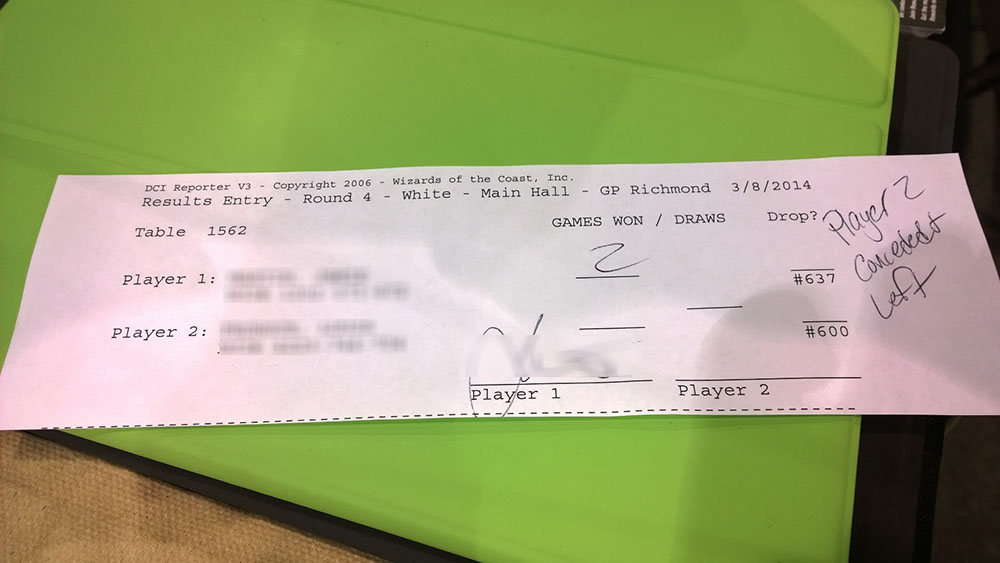
16.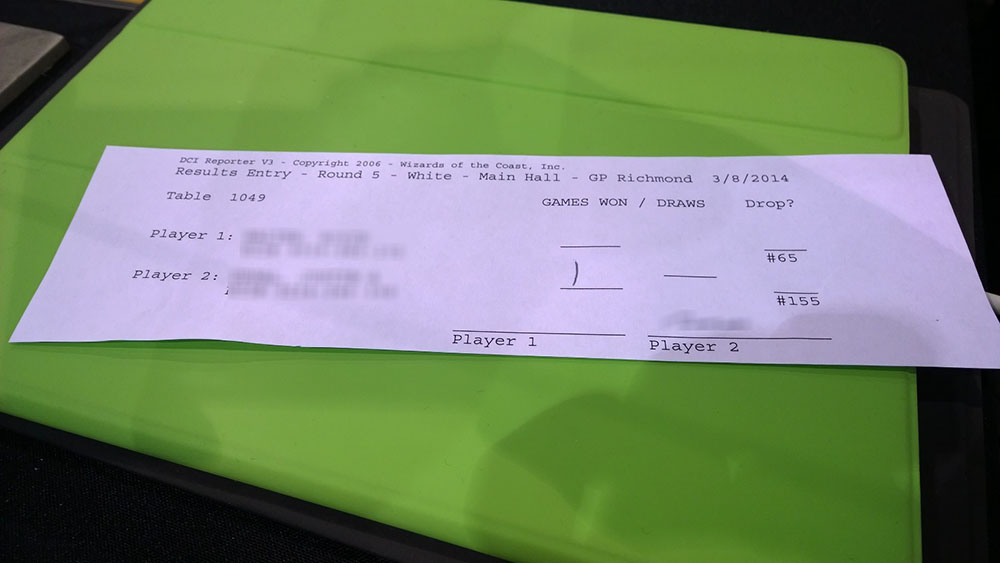
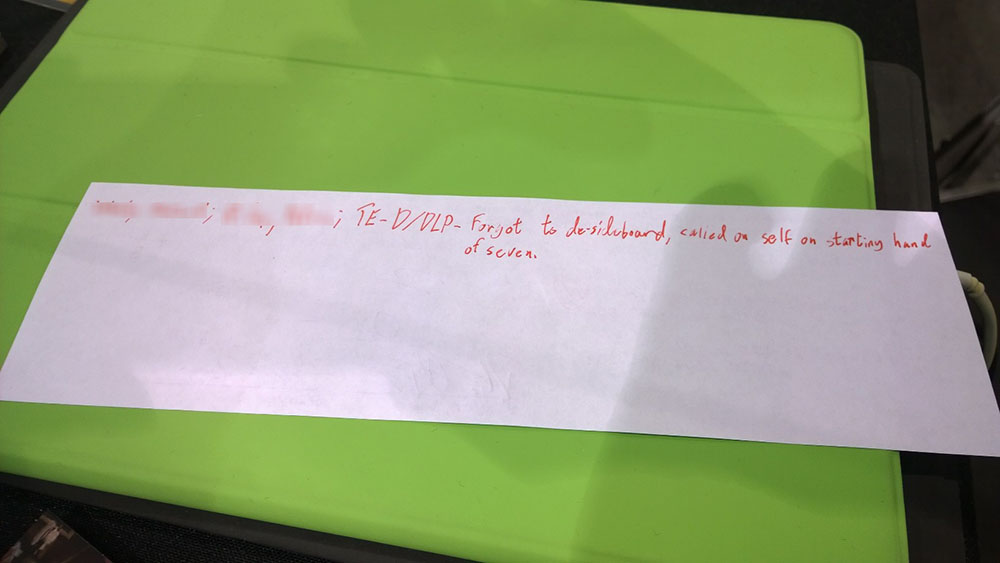
17.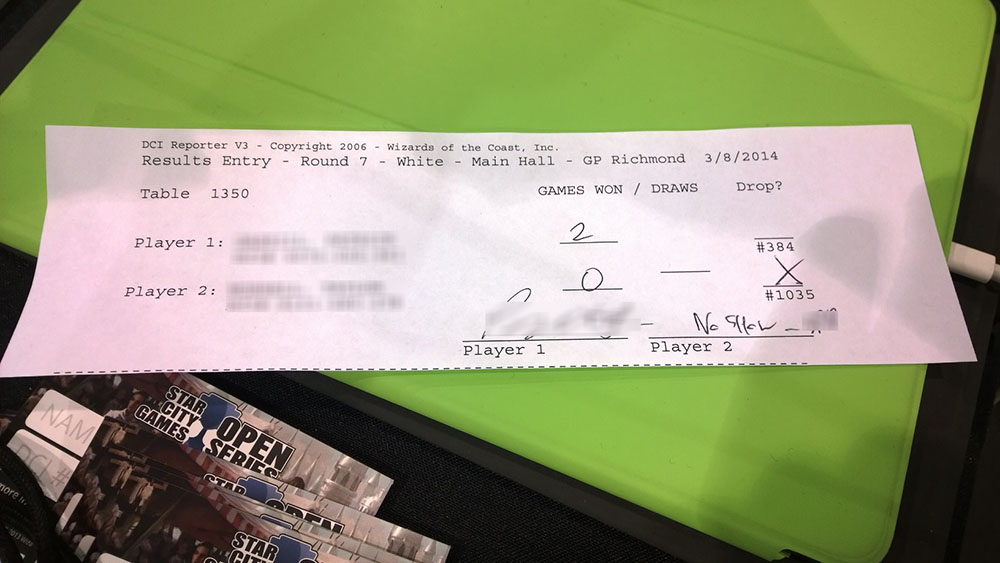
18.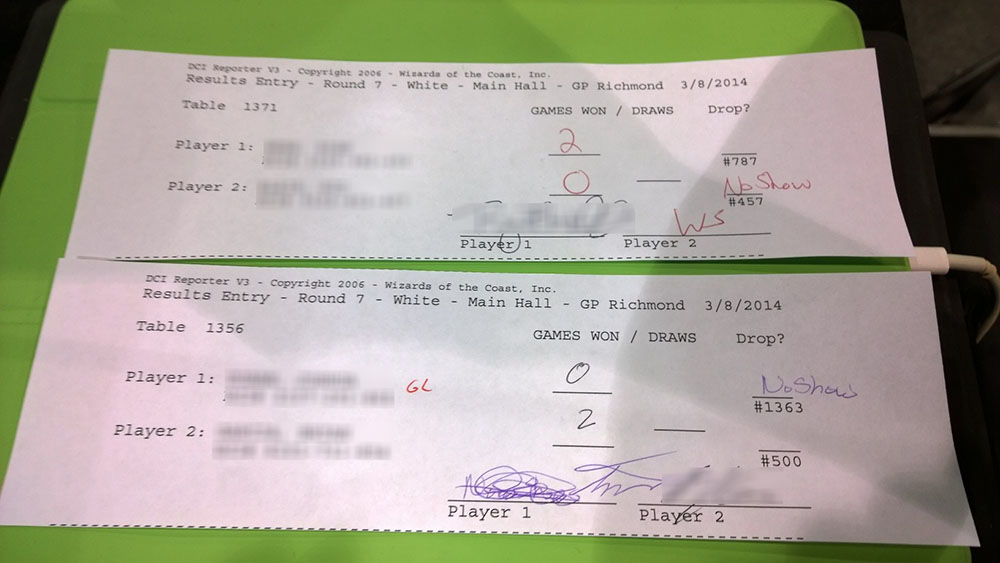
19.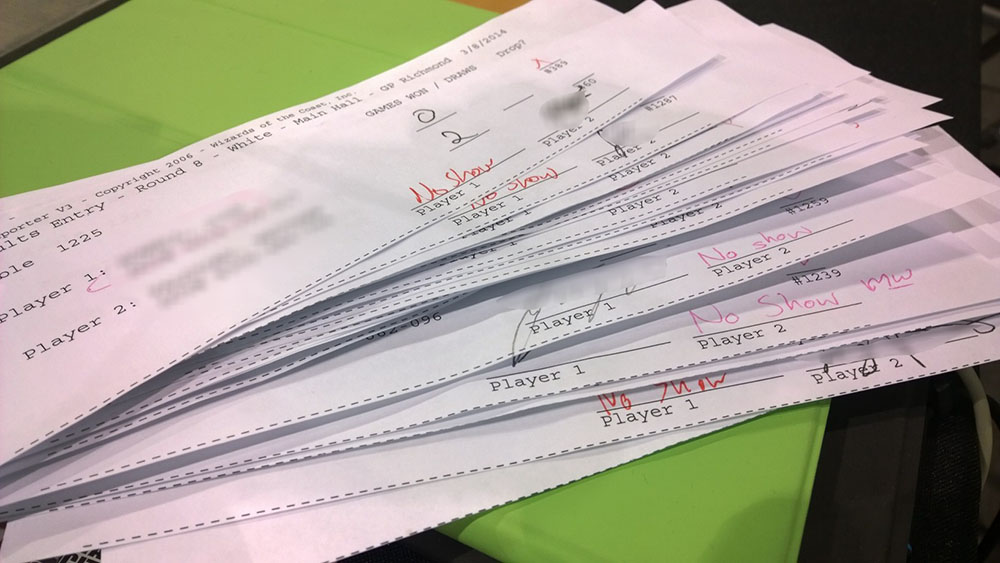
20.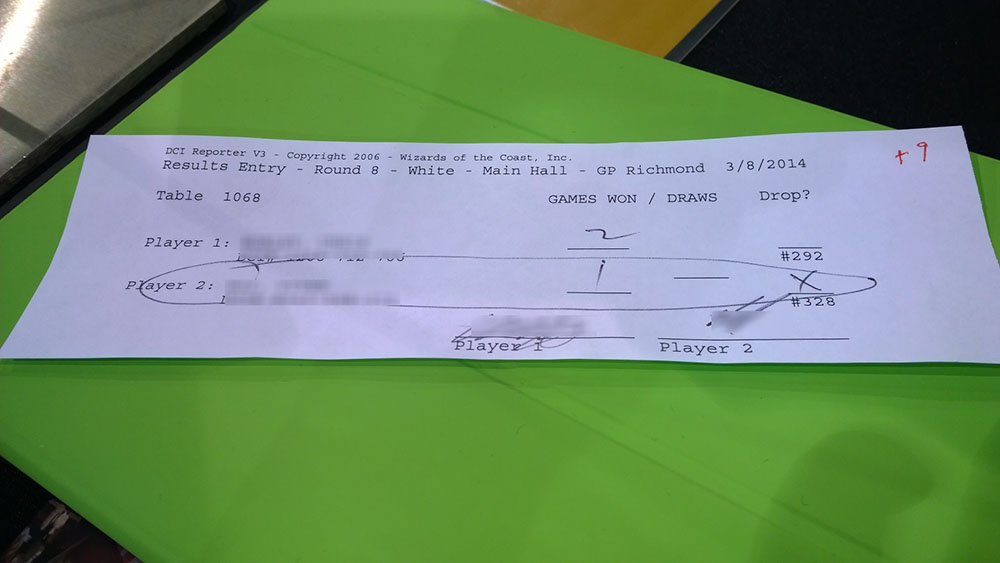
Phew. Answers to follow. In the meantime, an interlude inspired by David de la Iglesia, who I hear also was trying to avoid mention by name (Oops!), who wishes I would spend more time talking about happier things.
Credit appropriately, but steal shamelessly. There are good ideas all around you, and you’re doing yourself a disservice if you don’t steal the best of these and make them your own. A great example of this which has at least partially spread over the last year is Kevin Desprez’ drop list by player number, which speeds drop list processing by an order of magnitude at the small cost of creating the player number list so people can look up their numbers.
Here’s one that debuted in Richmond, courtesy of Riki Hayashi – the tilted result slip box, or simply “the wedge”, modeled by Riki and his first beneficiary, Kali Anderson.

In Kali’s effusive words, the net effect of the tilted box is that people actually look and see that slips are lined up and are instinctively encouraged to orient their slip as well. Gravity assists and keeps things in a single orderly pile, which solves a lot of the problems that can slow you down during mass result slip entry.
Less new, but no less germane, David himself’s emphasis at the end of round on getting away from the stage and out in the field to find any matches that are going on. Still need to get to posting on end of round procedure, but the seek and destroy method that is the outstanding table list makes much more sense when it’s a small handful that need to be located than when there are still a hundred matches going on that simply need some widespread coverage.
And on the staffing end of the world, some interesting preregistration innovations coming from some late night discussions with Jared Sylva, which … well, that’ll be a story for the future, I suppose.
All right, enough cheerful for now. Let’s talk about those result slips, shall we? Some of these are player problems, some are judge problems – anyone can mess up a slip.
1) (Judge) You can infer from the front, but it’s clear from the back, this is a classic No Show penalty. Except … without the penalty in an easy to parse sense. Technically, the information is there, but by only putting the data on the back, now you have to flip the slip over, when a No Show is simple enough to express on the front. More problematically, the player who didn’t show up wasn’t dropped, which leaves the scorekeeper wondering whether that was intentional and the player should be kept in. In this case, it turned out just to be a judge oversight, but mash all this together and you end up with a slip that takes way longer than it ought to in order to decipher and verify.
2) (Judge) Closer … sort of. At least this says “No Show”. But who’s the judge? And why is the score missing? So really, just as difficult to file (though, pro-tip – just use yourself for no show penalties if you can’t figure out which judge it was, since it’s pretty straightforward) . And just as disruptive, because you have to skip that beat to think about it.
3) (Player) Why is this player’s name circled? If you haven’t picked it up yet, you will by the end of this post – the unusual is the enemy of the good (unless something actually unusual happened). There seems to be a small subset of players that think it’s helpful to circle the name of the player that wins. While this might ordinarily merely be benignly unnecessary, it also is the case that some judges circle names to indicate a penalty, meaning that this requires extra work to see if there’s a penalty. And again, anything out of the ordinary requires a bit of investigation, so just don’t do this.
4) (Player) Tardiness penalty here indicates a game loss. But the final score is 1-0. Was it probably the case that this was a 2-0 victory? Yes. Enough so that if time is short, we’ll just assume it that way. But is it possible that you didn’t finish any real games and the real score is 1-0? Yup. And it’s also possible that you just screwed up filling out the result dealing with the game loss. And either way … yup, another one of those results that makes you stop and think, which totally harshes our mellow.
5) (Judge) This one’s a bit more subtle. Looks like a no show that turned out not to be a no show, so the judge has crossed that portion out so that the player doesn’t get dropped. So what’s the issue here? It’s subtle, but as you see, there is a different penalty instead, and there isn’t the usual mark that suggests that you should turn the slip around to find it. The judge’s signature hints at this, if you notice this – turns out, the signature field is actually one of the least noticeable, though, as you’re moving quickly through slips, as it isn’t in the main eye flow. In this case, the weirdness of the crossed out no show will probably slow things down enough to notice and look, but it’s still safest to put a mark by the person getting the penalty …
6) (Player) … a mark kind of like this. Except this slip has no penalty. My best guess is a player left this mark, for a reason I can’t discern. Don’t do this. It looks like a penalty and slows things down.
7) (Player) Nothing here but scores and signatures, what could possibly be wrong here? Well, tell me – is that first number a 1 or a 2? Yes, next to the second number, it’s more clearly a 1 since the latter one looks clearly like a 2. But you did the comparison. Bam, flow interrupted. Please write your numbers clearly.
8) (Player) This is super-clear, and it seems like it ought to be a good thing to be explicit about what you’re doing, so this should be exemplary, right? Well … not exactly. A mark in the drop column can also be clear, and the note is text that I now have to stop, read, and parse. Disrupted again. You’re probably tiring of the recurring theme at this point, but keeping things normal is vital. The attempt at clarity is absolutely appreciated. I recommend you keep things clear for a drop by just initialing in the drop column.
9) (Judge) This is like 7, but it’s worse, because now it’s in a different pen, and in this case, specifically a red pen. This usually signifies a judge mark, and usually judge marks mean to pay close attention. You actually can infer quite a bit based on pen types/colors, but in this case, that backfires. There was no penalty or anything else here, was just a random mark.
10) (Judge) This is an interesting combination of lessons from 8 and 9. Different color mark means it was filled in after the fact, and red suggests judge. But it’s the winner dropping. This is, in and of itself, out of the ordinary. I actually had multiple cases of this over the weekend, and sometimes it’s actually the winner dropping, and sometimes it’s filled out wrong and the wrong person getting dropped. As a player or a judge, it’s vital that you drop the right person. And here is a case where we’re already dealing with something that isn’t normal, so take the time to make the note. “Winner dropping” or some other short note would clear this up quite well, and this is the sort of oddity that actually deserves a note to explain, unlike back in 8.
11) (Judge?) Simpler again. Blank spaces in the game results area are bad. They take some time to decipher – yeah, they usually mean 0, but not always. And in this case, the red pen gets me again … did a judge fill this out? Would that be because the opponent didn’t show? Are we missing a no show drop here?
12) (Player) One of them wants to drop twice? The other one doesn’t want to drop at all? I see this about once or twice a tournament. No idea what possesses someone to think we wanted the result written down twice, side-by-side, but there it is. Don’t do this. Marks in the drop column are serious.
13) (Player) Is that first player dropping or not? Kind of looks like a mark, that was then half-heartedly crossed off. I actually can’t remember whether this was a drop or not after we called him up, but I shouldn’t have to – what’s even worse than unnecessary clarity is total lack of clarity. Don’t make the extra marks if you really are dropping, and make sure you fully cross out or correct the mark if you aren’t. When in doubt, call a judge and have them help you.
14) (Judge) Game loss for … what? Probably tardiness. Which judge do I ask to confirm? If you do nothing else, when you issue a penalty, at least put your name so we can get details from you afterward if you remain busy.
15) (Both) I don’t know whether a player or a judge wrote that note, but there’s culpability here either way. A judge should be involved in this sort of situation. And once they are, they should make it clear what’s happening. Conceded and left for lunch, then is going to keep playing? Or conceded and dropped?
16) (Judge) It’s like the zombie 1, 4, and 11, but worse. There’s a penalty there on the back, but utterly no sign that it’s there. And the front is a disaster – 1 vs. blank?
17) (Judge) This one is super-subtle and also not that bad. All the data is there, but it’s in a place where it could easily be missed. The right tournament result will happen, as the player will get dropped, but the fact that there is a No Show penalty to assess might get missed since it was written in that nebulous signature place that is only sort of noticeable.
18) (Judge) Who is WS? There was more than one in this tournament. Assuming that I can recognize your initials or cat-scratch signature (in the case of the second one) is folly. Write out your name, please.
19 (Player) Sooooo many no shows. So many. This was round 8, and there were this may no shows, with under 300 matches total. These are a pain and take a ton of time – seriously, stop that.
20) (??) There’s no penalty written here, front or back, and the loser is circled. I never did make heads or tails of this, but whatever it was, whoever caused it should stop doing that.
Whew! Lots of ways to get these simple things wrong. Let’s band together and go for a little more of the good idea to steal, and less of the messed up result slip to deal … with.
























